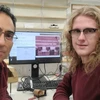SUNY Fredonia's undergraduates are invited to participate in the Assessment of Service and Civic Engagement survey, and possibly win one of a number of prizes in the process.
From April 4 to 15, students will be asked to complete a brief online survey which will be sent to their campus email that addresses their levels of participation and service in student government and numerous campus organizations. Academic clubs, honor societies, religious organizations, cultural groups and performance activities, organized sports, political and environmental advocacy groups and internships are to be reflected in responses.
The survey, being conducted by Sienna Research Institute in collaboration with New York Campus Compact, is an opportunity to learn more about what makes Fredonia's campus unique and how to best integrate student interests with community needs, said Dr. David Rankin, director of the Fredonia Academic Community Engagement Center and campus survey liaison.
A wide range of issues such as environmental concerns, public awareness and civic campaigns, hunger and nutrition, youth services, elder care, health and fitness, and economic opportunity and access are being considered, along with unique activities and issues identified by respondents. Students will also be asked how they learn about and engage in service activities, what motivating factors are present and what they perceive as obstacles to greater participation.
“We have very active and involved students on campus and in the community and the ASCE survey will provide greater understanding of how we can continue to strengthen service and engagement,” Dr. Rankin said.
Students who complete the short survey will be eligible to win one of more than 50 prizes in a random drawing. A total of 42 FSA gift cards, ranging in value from $10 to $50, will be awarded, as will $200 worth of merchandise valued at $12 to $20 each from the Buster Brown Bean Company.
Rankin said the survey will provide important information on how to reach out and link diverse student interests with desired service opportunities. A high response rate will provide a more comprehensive understanding of students’ service activities and interests and how to most effectively direct related attention and resources, he added.



